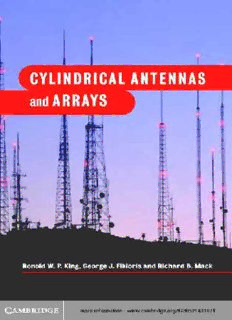
Cylindrical Antennas and Arrays PDF
Preview Cylindrical Antennas and Arrays
This page intentionally left blank Cylindrical Antennas and Arrays Cylindricalantennasaretheradiatingelementsinmostmajorradiocommunicationsystems, includingbroadcastingnetworks,cellulartelephonesystemsandradar.Inthisbook,theauthors presentpracticaltheoreticalmethodsfordeterminingcurrentdistributions,inputadmittancesand impedances,andfieldpatternsofawidevarietyofcylindricalantennasandarrays,includingthe isolatedantenna,thetwo-elementarray,thecirculararray,curtainarrays,Yagiandlog-periodic arrays,planararraysandthree-dimensionalarrays.Coveragealsoincludestheanalysisofhorizontal andverticalantennasover,onandintheearthandsea,largeresonantarraysofelectricallyshort dipolesandachapteronthetheoryandtechniquesofexperimentalmeasurement.Writtenbythree oftheleadingengineersinthefield,andbasedonworld-classresearchcarriedoutatHarvardover thelast40years,CylindricalAntennasandArraysisdestinedtobecomethebasicreferencefor practicingengineersandadvancedstudentsformanyyearstocome. RonoldW.P.KingisGordonMcKayProfessorofAppliedPhysics,EmeritusatHarvardUniversity. SincejoiningtheHarvardfacultyin1938,hehassupervisedtheresearchofover100Ph.D. students.HeisaLifeFellowoftheIEEE;aFellowoftheAmericanPhysicalSociety;anda memberoftheBavarianAcademyofSciencesandtheAmericanAcademyofArtsandSciences. HeholdstheDistinguishedServiceAwardfromtheUniversityofWisconsin(1973),theCentennial MedaloftheIEEE(1985),theHaroldPenderAwardfromtheUniversityofPennsylvania(1986), theDistinguishedAchievementAwardoftheIEEEAntennas&PropagationSociety(1991),the IEEEGraduateTeachingAward(1997),andtheChen-ToTaiDistinguishedEducatorAwardfrom theIEEEAntennas&PropagationSociety(2001). GeorgeJ.FikiorisisalecturerattheNationalTechnicalUniversityofAthens(NTUA)inGreece.After obtaininghisPh.D.atHarvardUniversityin1993heworkedforsixyearsasanelectronicsengineer attheAirForceResearchLaboratory,HanscomAFB,USAbeforejoiningtheNTUAin1999. Richard B. Mack is a consultant with his own company, Mack Consulting, specializing in electro- magneticmeasurementtechniques. Cylindrical Antennas and Arrays Revised and enlarged 2nd edition of ‘Arrays of Cylindrical Dipoles’ Ronold W. P. King GordonMcKayProfessorofAppliedPhysics,Emeritus,HarvardUniversity George J. Fikioris Lecturer,NationalTechnicalUniversityofAthens,Greece Richard B. Mack ConsultantinEMMeasurementTechniques,MackConsulting Cambridge, New York, Melbourne, Madrid, Cape Town, Singapore, São Paulo Cambridge University Press The Edinburgh Building, Cambridge , United Kingdom Published in the United States by Cambridge University Press, New York www.cambridge.org Information on this title: www.cambridge.org/9780521431071 © Cambridge University Press 2002 This book is in copyright. Subject to statutory exception and to the provision of relevant collective licensing agreements, no reproduction of any part may take place without the written permission of Cambridge University Press. First published in print format 2002 ISBN-13 978-0-511-06756-3 eBook (EBL) ISBN-10 0-511-06756-9 eBook (EBL) ISBN-13 978-0-521-43107-1 hardback ISBN-10 0-521-43107-7 hardback Cambridge University Press has no responsibility for the persistence or accuracy of s for external or third-party internet websites referred to in this book, and does not guarantee that any content on such websites is, or will remain, accurate or appropriate. Goodreasonsmust,offorce,giveplacetobetter. SHAKESPEARE Contents Preface pagexiii Prefacetofirstedition xvii 1 Introduction 1 1.1 Linearantennas 1 1.2 Maxwell’sequationsandthepotentialfunctions 3 1.3 PowerandthePoyntingvector 5 1.4 Thefieldofthinlinearantennas:generalequations 7 1.5 Thefieldoftheelectricallyshortantenna;directivity 11 1.6 Thefieldofantennaswithsinusoidallydistributedcurrents;radiation resistance 13 1.7 Impedanceofantenna:EMFmethod 16 1.8 Integralequationsforthecurrentdistribution 20 1.9 Directnumericalmethods 23 2 Anapproximateanalysisofthecylindricalantenna 31 2.1 Thesinusoidalcurrent 31 2.2 Theequationforthecurrent 32 2.3 Propertiesofintegrals 33 2.4 Rearrangedequationforthecurrent 36 2.5 Reductionofintegralequationtoalgebraicequation 36 2.6 Evaluationofcoefficients 39 2.7 Theapproximatecurrentandadmittance 40 2.8 Numericalexamples;comparisonwithexperiment 41 2.9 Theradiationfield 43 2.10 Anapproximatetwo-termtheory 48 2.11 Thereceivingantenna 50 vii viii Contents 3 Thetwo-elementarray 54 3.1 Themethodofsymmetricalcomponents 54 3.2 Propertiesofintegrals 57 3.3 Reductionofintegralequationsforphasesequencestoalgebraicequations 59 3.4 Thephase-sequencecurrentsandadmittances 62 3.5 Currentsforarbitrarilydrivenantennas;self-andmutualadmittancesand impedances 64 3.6 Currentsforonedriven,oneparasiticantenna 66 3.7 Thecouplet 67 3.8 Fieldpatterns 68 3.9 Thetwo-termapproximation 70 4 Thecirculararray 79 4.1 Integralequationsforthesequencecurrents 80 4.2 Sequencefunctionsandarrayproperties 86 4.3 Self-andmutualadmittances 88 4.4 Currentsandfields;arrayswithonedrivenelement 95 4.5 Matrixnotationandthemethodofsymmetricalcomponents 103 4.6 Generalformulationandsolution 107 5 Thecircuitandradiatingpropertiesofcurtainarrays 112 5.1 Comparisonofconventionalandtwo-termtheories 112 5.2 Two-termtheoryofcurtainarrays 114 5.3 Example:thethree-elementarray 124 5.4 Electronicallyscannedarrays 128 5.5 Examplesofthegeneraltheoryforlargearrays 137 5.6 Thespecialcasewhenβ h =π/2 148 0 5.7 Summary 151 6 Arrayswithunequalelements:parasiticandlog-periodicantennas 153 6.1 Applicationofthetwo-termtheorytoasimpleparasiticarray 153 6.2 Theproblemofarrayswithparasiticelementsofunequallengths 160 6.3 ApplicationtotheYagi–Udaarray 162
Description: